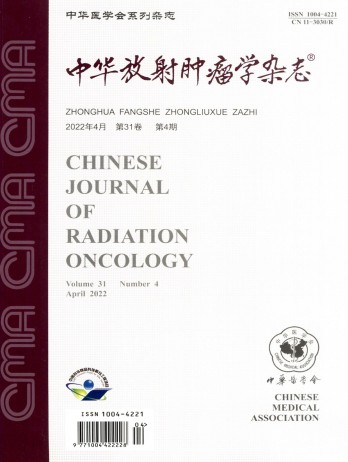Comparison of clinical prognosis of chemo-radiotherapy and surgical treatment for patients with limited stage small cell lung cancer after matching
引用次数: 1
Abstract
Objective To compare the overall survival (OS), progression-free survival (PFS) and brain metastasis free survival (BMFS) between the chemo-radiotherapy and surgical treatment for patients with limited stage small cell lung cancer (LS-SCLC). Methods Clinical data of 69 patients diagnosed with LS-SCLC undergoing surgery in Zhejiang Cancer Hospital between 2000 and 2016 were collected. According to T, N stage, treatment duration, age, gender and whether or not prophylactic cranial irradiation (PCI), 69 patients of 503 LS-SCLC patients who underwent standard radiochemotherapy were assigned into the radiochemotherapy group by using the pair-matched case-control method. Results Among 138 patients, 69 cases were allocated into the surgery group (24 cases of stage Ⅰ, 14 cases of stage Ⅱ and 31 cases of stage Ⅲ) and 69 cases in the radiochemotherapy group (24 cases of stage Ⅰ, 14 cases of stage Ⅱ and 31 cases of stage Ⅲ). The median OS time was 37.1 months (95%CI: 24.1-50.2 months) in surgery group and 45.0 months (95%CI: 15.8-74.2 months) in the radiochemotherapy group. The 2-and 5-year OS rates were 60% and 45% in the surgery group, and 64% and 45% in the radiochemotherapy group (P=0.846). The median PFS time was 27.1 months (95%CI: 0.00-60.3 months) in the surgery group and 36.2 months (95%CI: 20.9-51.4 months) in the radiochemotherapy group. The 2-and 5-year PFS rates were 52%, and 38% in the surgery group, and 56% and 40% in the chemo-radiotherapy group (P=0.610). The 2-and 5-year BMFS rates were 81% and 76% in the surgery group, and 84% and 80% in the radiochemotherapy group (P=0.774). The 5-year OS rate (62% vs. 40%, P=0.038) and 5-year PFS rate (80% vs.40%, P=0.048) for patients with stage Ⅰ LS-SCLC in the surgery group were significantly higher than those in the radiochemotherapy group. However, the 5-year BMFS rate in patients with stage Ⅰ LS-SCLC did not significantly differ between two groups (92% vs.95%, P=0.816). The 5-year OS rate (41% vs.51%, P=0.946), 5-year PFS rate (65% vs.42%, P=0.280) and 5-year BMFS rate (75% vs.78%, P=0.720) for stage Ⅱ SCLC did not significantly differ between two groups. As for stage Ⅲ SCLC patients, the OS rate (25% vs.48%, P=0.220), 5-year PFS rate (28% vs.36%, P=0.333) and 5-year BMFS rate (76% vs. 74%, P=0.84) did not significantly differ between two groups. Conclusions Surgical treatment can bring survival benefits to patients with stage Ⅰ LS-SCLC. The survival prognosis of stage Ⅱ patients is equivalent between two groups. Patients with stage Ⅲ LS-SCLC receiving radiochemotherapy obtain better survival trend compared with those undergoing surgery. The conclusion remains to be validated by studies with larger sample size or prospective investigations. Key words: Lung neoplasm/surgery; Lung neoplasm/radiochemotherapy; Prognosis有限期小细胞肺癌配术后放化疗与手术治疗的临床预后比较
目的比较癌症小细胞肺癌(LS-SCLC)患者化疗和手术治疗的总生存率(OS)、无进展生存率(PFS)和无脑转移生存率(BMFS)。方法收集2000~2016年浙江省癌症医院手术治疗的69例LS-SCLC患者的临床资料。根据T、N分期、治疗时间、年龄、性别和是否预防性颅骨照射(PCI),采用配对病例对照法将503例接受标准放化疗的LS-SCLC患者中的69例分为放化疗组。结果138例患者中,69例分为手术组(Ⅰ期24例,Ⅱ期14例,Ⅲ期31例)和放化疗组69例(Ⅰ期2 4例,Ⅱ阶段14例,Ⅳ阶段31例)。手术组的中位OS时间为37.1个月(95%可信区间:24.1-50.2个月),放化疗组为45.0个月(95%CI:15.8-74.2个月)。手术组的2年和5年OS发生率分别为60%和45%,放化疗组为64%和45%(P=0.846)。手术组和放化疗组的中位PFS时间分别为27.1个月(95%可信区间:0.00-60.3个月)和36.2个月(95%可信区间:20.9-51.4个月)。手术组2年和5年PFS发生率分别为52%和38%,放化疗组分别为56%和40%(P=0.610),手术组Ⅰ期LS-SCLC患者的5年OS发生率(62%对40%,P=0.038)和5年PFS发生率(80%对40%,P=0.048)明显高于放化疗组。然而,Ⅰ期LS-SCLC患者的5年BMFS发生率在两组之间没有显著差异(92%对95%,P=0.816)。Ⅱ期SCLC的5年OS发生率(41%对51%,P=0.946)、5年PFS发生率(65%对42%,P=0.280)和5年BMFS发生率(75%对78%,P=0.720)在两组间没有显著差异。对于Ⅲ期SCLC患者,OS发生率(25%vs.48%,P=0.220)、5年PFS发生率(28%vs.36%,P=0.333)和5年BMFS发生率(76%vs.74%,P=0.84)在两组之间没有显著差异。结论手术治疗可提高Ⅰ期LS-SCLC患者的生存率。两组Ⅱ期患者的生存预后相当。与接受手术的患者相比,接受放化疗的Ⅲ期LS-SCLC患者获得了更好的生存趋势。这一结论有待于更大样本量的研究或前瞻性调查的验证。关键词:肺部肿瘤/外科;肺部肿瘤/放化疗;预后
本文章由计算机程序翻译,如有差异,请以英文原文为准。
求助全文
约1分钟内获得全文
求助全文
来源期刊
自引率
0.00%
发文量
6375
期刊介绍:
The Chinese Journal of Radiation Oncology is a national academic journal sponsored by the Chinese Medical Association. It was founded in 1992 and the title was written by Chen Minzhang, the former Minister of Health. Its predecessor was the Chinese Journal of Radiation Oncology, which was founded in 1987. The journal is an authoritative journal in the field of radiation oncology in my country. It focuses on clinical tumor radiotherapy, tumor radiation physics, tumor radiation biology, and thermal therapy. Its main readers are middle and senior clinical doctors and scientific researchers. It is now a monthly journal with a large 16-page format and 80 pages of text. For many years, it has adhered to the principle of combining theory with practice and combining improvement with popularization. It now has columns such as monographs, head and neck tumors (monographs), chest tumors (monographs), abdominal tumors (monographs), physics, technology, biology (monographs), reviews, and investigations and research.

 求助内容:
求助内容: 应助结果提醒方式:
应助结果提醒方式:


